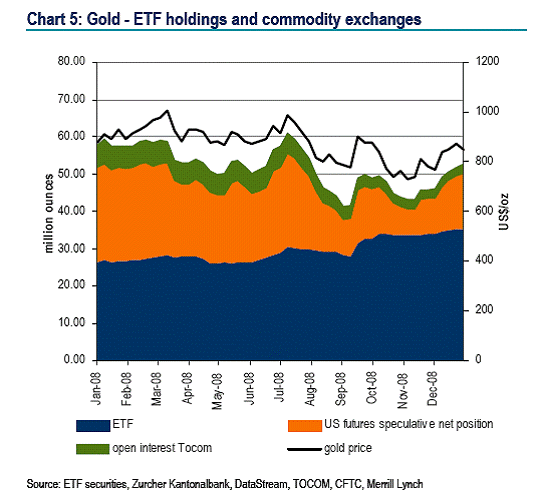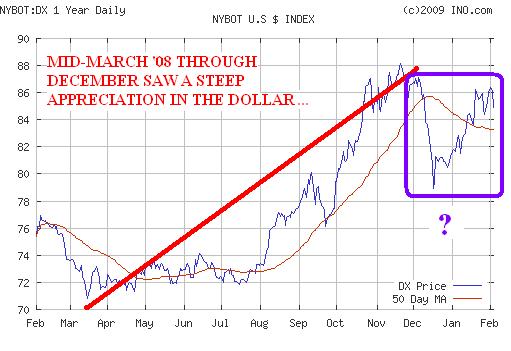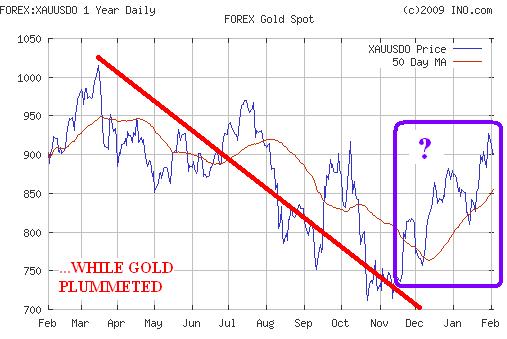Gold is Dead and Neitzsche had Nothing to do with it
Commodities / Gold & Silver 2009 Feb 05, 2009 - 10:53 AM GMTBy: Oxbury_Research
 “Gold kind of scares me because very often the people involved with it seem to be slightly insane.”– James Montier, head of equity research, Societe Generale, London
“Gold kind of scares me because very often the people involved with it seem to be slightly insane.”– James Montier, head of equity research, Societe Generale, London
Some say that it doesn't matter when you buy gold, that you should buy it regularly and always, and that it represents the only true store of value. Fair enough. When all is said and done, buying gold may be the only means of acquiring real wealth for the very long term. Especially today, when all major currencies are devaluing by hook or by crook – some voluntarily, others not so – it behooves an investor to shore up his gold holdings.
Yet at the same time, from a pure investment point of view, it's never a good idea to sink money into a depreciating asset. That's what the smart guys call “dead money.” And when it comes to gold, which neither pays a dividend nor offers interest, a decline in value against other asset classes is not something we want to bear, if given the choice.
That in mind, we come (again) to comment on the current price level of the yellow metal, and to suggest what is to be done for those who currently hold bullion and/or gold stocks, and those who are considering making an imminent purchase.
First the case for immediate purchase:
- Gold is a hedge against inflation (so they say), and we have massive inflation in the pipeline .
- Gold is a safe haven and will rise due to continued financial troubles globally.
- Gold is the only currency capable of replacing the fiat currency monstrosities now in use the world over.
- Bullion supply is declining.
- Investment demand for gold is underpinning a steady, unstoppable rise in price. The chart below clearly shows the increased role ETFs are playing on the demand side – irrespective of the price of the metal.

And now the case against:
- Weak fabrication demand. Gold jewellery accounts for about 60% of global gold sales. In times like these, though, it's hard to imagine buying the dear Mrs. another dear piece of jewellery.
- A strong dollar would take the wind out of gold's sales, and could drive it significantly lower.
It's to this latter point we now turn our attention.
Look here

You're looking at a chart of the U.S. Dollar Index for the last year. We've brought it to make a comparison with gold, but first a brief explanation.
Gold and the dollar have an inverse relationship; when one is rising, the other falls. It hasn't always been this way, but long enough to be relevant to those of us who care about timing our gold purchases. According to Bloomberg , gold and the dollar have had a
-0.7% correlation over the last five years. That's significant. Now look here:

This is gold over the same time frame. Note the correlated decline in price.
Research from the World Gold Council shows that the correlation between gold and the dollar is stronger when the latter is falling. At such times “investors tend to diversify away from dollar-linked assets, boosting the negative relationship between the two.”
Fine. But that leads us to the $64,000 question: what to make of the purple, boxed areas on the right side of both charts.
On the one hand, we have a dollar that pulled back significantly after its rise into December, and which is now moving up to test its previous highs. And on the other, we have gold's uninterrupted climb of $200 from its late November lows around $720. How do we account for this? What happened to the inverse relationship? Should we expect things to look different? Or is this just one of those times (30%) when the two don't correlate?
Or could it be that the World Gold Council's research explains it. Could it be that the dollar's fall led to a “heightened” inverse correlative with gold, a sort of extraordinary stimulo-genesis of the AU tissue in goldbugs the world over that led to frenzied buying and will yet prove their undoing when they wake up to the fact that the dollar may yet spike to new highs!?
And what will happen to their gold rally then, friends?
The NEGATIVE CORRELATIVE (ha, ha, ha – I'm a bloody genius!) has been delayed. But it will not be denied!
More butter! NOW!
Matt McAbby
Analyst, Oxbury Research
After graduating from Harvard University in 1989, Matt worked as a Financial Advisor at Wood Gundy Private Client Investments (now CIBC World Markets). After several successful years, he moved over to the analysis side of the business and has written extensively for some of corporate Canada's largest financial institutions.
Oxbury Research originally formed as an underground investment club, Oxbury Publishing is comprised of a wide variety of Wall Street professionals - from equity analysts to futures floor traders – all independent thinkers and all capital market veterans.
© 2009 Copyright Oxbury Research - All Rights Reserved
Disclaimer: The above is a matter of opinion provided for general information purposes only and is not intended as investment advice. Information and analysis above are derived from sources and utilising methods believed to be reliable, but we cannot accept responsibility for any losses you may incur as a result of this analysis. Individuals should consult with their personal financial advisors.
Oxbury Research Archive |
© 2005-2022 http://www.MarketOracle.co.uk - The Market Oracle is a FREE Daily Financial Markets Analysis & Forecasting online publication.



